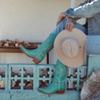
From crime-fighting figures like Pat Garrett and Bass Reeves to the rough n’ tumble outlaws they set out to stop, we’ve put together several names of cowboys who made their mark in the image of the 19th and 20th-century American west still celebrated in books, movies, TV, and urban tales today.
Read on to discover 10 of the most infamous names of cowboys and outlaws any western-obsessed guy or gal ought to have handy for the next Western-themed trivia night.
10 Famous Cowboy Names from the American West
William Frederick Cody – “Buffalo Bill”

Born: February 26th, 1846, in Le Claire, Iowa Territory
Died: January 10th, 1917, in Denver, CO
Cause of Death: Kidney Failure
William Frederick Cody – best known as “Buffalo Bill,” was a buffalo hunter, U.S. army scout, Indian fighter, and famous showman of Buffalo Bill’s Wild West and Congress of Rough Riders of the World. This multicultural traveling show showcased Western icons like Annie Oakley (read more about her below) and other global groups, including the Mongols, Turks, Arabs, and South American gauchos.
Cody is considered one of the key contributors to the colorful, fantastical image of the American West celebrated worldwide. At one point, Cody was the most recognizable man on earth!
In addition to his historic traveling show, Cody was also a Freemason, a proponent of American Indian treaty rights, a supporter of the Women’s Suffrage Movement, and a founder of Cody —– a city in Northwest Wyoming, established in 1896.
William Frederick Cody died in 1917 at 70 from kidney failure. To this day, there is much debate on whether Buffalo Bill is buried in Wyoming or if his remains lay in Colorado.
Jesse James

Born: September 5th, 1847, near Kearney, MO
Died: April 3rd, 1882, in St. Joseph, MO
Cause of Death: Gunshot Wounds
Looking for famous cowboys from the other side of the tracks? Jesse James is your man. This American outlaw and leader of the James-Younger Gang was ironically the son of a preacher raised in the “Little Dixie” area of Western Missouri. James shared strong support for the Southern cause, eventually joining the Pro-Confederate guerilla fighters (the “bushwhackers”) during the Civil War alongside his brother, Frank James.
After the war, the two brothers and their gang pursued criminal careers full-time, robbing banks, trains, and stagecoaches with brutal force across the Midwest. James’s criminal enterprise continued for several years, but in 1882, new recruit Robert Ford shot and killed James in hopes of collecting the bounty of his head. James was 34 years old. Before his death, James married his first cousin, Zerelda Mimms, and had four children. His remains are buried in Mount Olivet Cemetery in Kearney, Missouri.
Henry McCarty – “Billy the Kid”

Born: 1859 in New York City, NY
Died: July 14th, 1881, in Fort Sumner, NM
Cause of Death: Gunshot Wounds
Henry McCarty, infamously known as “Billy the Kid” or by his pseudonym, “William H. Bonney,” was an American outlaw and gunfighter infamous for his short yet full life of felony. An orphan by the age of 15, McCarty quickly became entangled in a life of crime, committing everything from petty theft and robbery to murder and becoming a federal fugitive before the age of 18.
McCarty fled to Arizona from New Mexico, where he committed another murder of a local blacksmith. This act forced McCarty back to New Mexico, where he became a cattle rustler, cowboy, and ranch hand before joining the Regulators in the Lincoln County War of 1878.
After American newspapers reported stories of his crimes, McCarty was captured by Lincoln County Sheriff Pat Garrett and sentenced to death by hanging. In true Henry McCarty fashion, he escaped and evaded capture for roughly two months before Garrett found, shot, and killed him in Fort Sumner, New Mexico. His remains are buried at the Old Fort Sumner Cemetery and Chamber of Commerce in Fort Sumner, New Mexico.
Pat Garrett

Born: June 5th, 1850, in Chambers County, AL
Died: February 29th, 1908, in Las Cruces, NM
Cause of Death: Gunshot Wounds
The American West is filled with famous cowboys and the outlaws they set out to stop. One hero-like figure responsible for stopping infamous criminal Henry ‘Billy the Kid’ McCarty was Pat Garrett.
Pat Garrett worked as a buffalo hunter in Texas, a cowboy at Fort Sumner, and in 1880, was elected sheriff of Lincoln County, New Mexico. After obtaining a deputy U.S. Marshal’s commission, Garrett could cross state lines, which aided his capture and eventual killing of the West’s infamous Henry “Billy the Kid” McCarty. After these events, Garrett would co-author a book, The Authentic Life of Billy the Kid.
In his lifetime, Garrett fathered eight children and held titles of Texas Rangers captain, El Paso Collector of Customs, and a “White House Gunfighter,” appointed by President Theodore Roosevelt.
On February 29th, 1908, Pat Garrett was shot and killed by an unidentified person. The killing is believed to be sparked by a land agreement altercation. A memorial marking the location of Garrett’s murder stands today in Las Cruces, New Mexico. He is buried alongside his family and descendants at the Las Cruces Masonic Cemetery.
Robert Leroy Parker – “Butch Cassidy”

Born: April 13th, 1866, in Beaver, Utah Territory
Died: November 17th, 1908 in Bolivia
Cause of Death: Gunshot Wounds
Robert Leroy Parker, better known as “Butch Cassidy,” was an American outlaw famed for his lifetime of crime — particularly bank and train robberies and the formation of his gang, the “Wild Bunch.”
After fleeing home as a teen, Parker found work as a butcher’s apprentice in Rock Springs, Wyoming (this is where he got his nickname “Butch”), and on several ranches, including the dairy ranch where he met cattle thief Mike Cassidy — a last name he would adopt as his own.
With more than a decade of criminal activity in the west, Parker fled to Bolivia, where he is believed to be shot and killed, either by the Bolivian Army or by turning the gun on himself. The whereabouts of Parker’s remains are unknown.
John Henry “Doc” Holliday

Born: August 14th, 1851, in Griffin, GA
Died: November 8th, 1887, in Glenwood Springs, CO
Cause of Death: Tuberculosis
One famous cowboy name you may not be familiar with (but ought to know of) is John Henry ‘Doc” Holliday.
The son of a well-to-do mayor, Holliday received a classical education, which would help him become a successful dentist. It doesn’t sound much like an outlaw or a cowboy, right? Not so fast! Over his lifetime, Holliday developed a reputation for killing more than 12 men, though evidence suggests this number is closer to one to three.
At the age of 21, Holliday was diagnosed with tuberculosis, a disease his mother perished from when he was just 15, and which he contracted while caring for her. This diagnosis prompted Holliday’s move to the American Southwest, hoping that warmer climates would ease his symptoms. This journey would lead him down a road of gambling and gunfighting, including his most notable altercation, the gunfight at the O.K. Corral in Tombstone, Arizona.
After multiple run-ins with the law, Holliday finally succumbed to his illness in the Hotel Glenwood at just 36 years old. It is believed that Holliday’s remains are buried in the Linwood Cemetery, which overlooks Glenwood Springs. However, some speculate his father had his body exhumed and reburied in his hometown of Griffin, Georgia.
Phoebe Ann Mosey – Annie Oakley (1860-1926)

Born: August 13th, 1860, in Darke County, OH
Died: November 3rd, 1926, in Greenville, OH
Cause of Death: Pernicious Anemia
One famous cowboy name —ahem—cowgirl name you ought to have stored in your memory bank is the world-famous Phoebe Ann Mosey — best known as “Annie Oakley.” A star sharpshooter in Buffalo Bill's Wild West Show, Mosey’s claim to fame was built on talent and entertainment rather than a life of crime.
This famous cowgirl performed for royalty, entertaining everyone from Queen Victoria and King Umberto of Italy to Marie Francois Sadi Carnot of France — not to mention hundreds, even thousands of others across the globe. She married Frank Butler on June 20th, 1882, in Windsor, Ontario, roughly one year after their first meeting at a Baughman & Butler shooting act. The two performed together in Buffalo Bill's Wild West show for many years.
Throughout her career and life, Mosey was a strong supporter of women’s rights. She was not only dedicated to teaching women self-defense but promoting the service of women in U.S. armed forces combat operations as well.
Phoebe Anne Mosey died of complications from pernicious anemia at the age of 66. After her passing, it was discovered that Mosey’s entire fortune was spent on her charities and family.
Mosey is still remembered today as one of the West’s “Watanya Cicilla,” or “Little Miss Sure Shot” — a nickname given to her by the infamous Sitting Bull, the chief of the Sioux Nation, and performer in Buffalo Bill’s Wild West Show. Her cremated remains are buried at Brock Cemetery near Greenville, Ohio.
Bass Reeves (1838-1910)

Born: July 1838, in Crawford County, AK
Died: January 12th, 1910, in Muskogee, OK
Cause of Death: Bright’s Disease
Another famous cowboy name worth writing down is Bass Reeves. Born into slavery in 1838, Bass lived his early years in bondage. During the Civil War, Bass was forced to enlist in the Confederate Army alongside his owner, George R. Reeves. At some point during the war, Bass escaped and fled to Indian Territory to live among the Cherokee, Creeks, and Seminoles, where he would remain until the 13th Amendment was passed and slavery was abolished.
As a free man, Bass Reeves moved back to Arkansas to begin his independent life as a farmer. In 1975, Reeves was appointed as the federal judge for the Indian Territory, marking the start of his career as an American law enforcement official. Reeves would go on to serve as the first black deputy U.S. Marshal west of the Mississippi.
During Reeve’s law enforcement career, he successfully made over 3,000 arrests of dangerous, wanted fugitives, and killed a handful himself in self-defense. Bass Reeves married twice and had 11 children. In 1910 at the age of 71, Bright’s disease claimed Reeve’s life. His remains are buried at the Union Agency Cemetery, which is now privately owned and inaccessible to the public. In 1992, Reeves was inducted into the National Cowboy & Western Heritage Museum’s Hall of Great Westerners.
John Hughes
Born: February 11th, 1855, in Cambridge, IL
Died: June 3rd, 1947, in Austin, TX
Cause of Death: Suicide
John Hughes was a celebrated Western cowboy, Texas Ranger, and in his later years, an author. At the age of 14, Hughes left his home state of Illinois to pursue a career as a cowboy. After working on a ranch in Kansas, Hughes picked up and headed further west to Indian Territory, where he learned the ways of the Choctaw, Osage, and Comanche Indians. He again picked up and headed to Texas, where he would become both a farm owner and — unknown to him at the time – one of the world’s most celebrated Texas Rangers.
Hughes infamously retrieved several stolen horses from a neighbor, committing himself to the pursuit that lasted several months. This brave and dedicated act caught the attention of local Texas Ranger Ira Aten, who recruited Hughes as a Ranger — a position he would proudly serve until retirement in 1915.
It is believed that the character “Lone Ranger” is inspired by Hughes, who is highly regarded as one of the most influential Texas Rangers in American history. In 1940, Hughes was awarded a Certificate of Valor for his work as a Ranger. At the age of 92, Hughes died by suicide. He is buried in the Texas State Cemetery located in Austin, Texas.
Lucille Mulhall
Born: October 21, 1855, in St. Louis, MO
Died: December 21, 1940, in Logan County, OK
Cause of Death: Automobile Accident
Last on our list of famous names of cowboys isn’t a cowboy or an outlaw at all! Lucille Mulhall was a tried-and-true cowgirl and one of the first females to compete with men in riding and roping events.
This rough n’ tumble performer was awarded nicknames of “Rodeo Queen” and “Queen of the Western Prairie,” among countless other variations of the two. Mulhall would eventually star in the Miller Brothers’ 101 Ranch Wild West Show and subsequently produce her own rodeo in 1916 before retiring to her family’s ranch in 1922, located in what is now known as Mulhall, Oklahoma. Decades following her tragic death in 1940, Lucille Mulhall was inducted into the Rodeo Hall of Fame and National Cowgirl Museum and Hall of Fame.
Visit the Boot Camp today to discover more stories, tips, and modern fashion favorites inspired by Western life.







